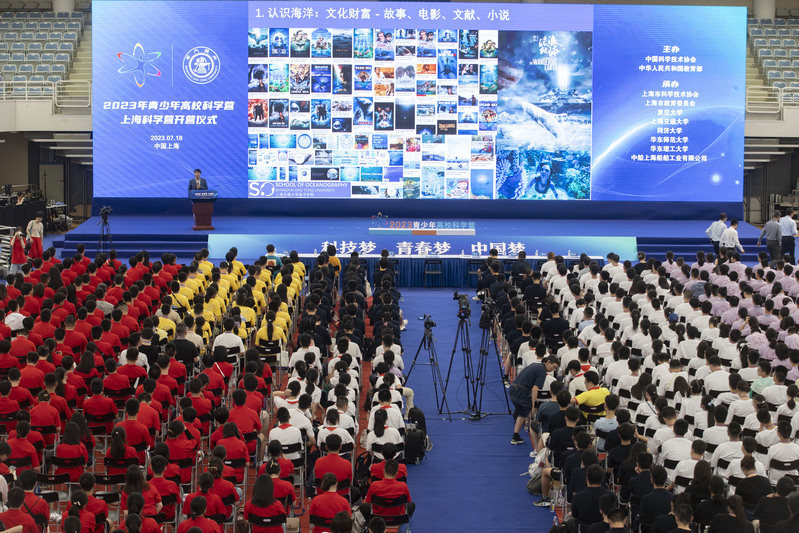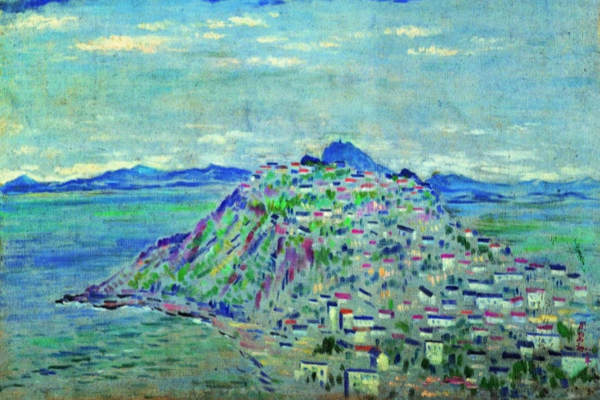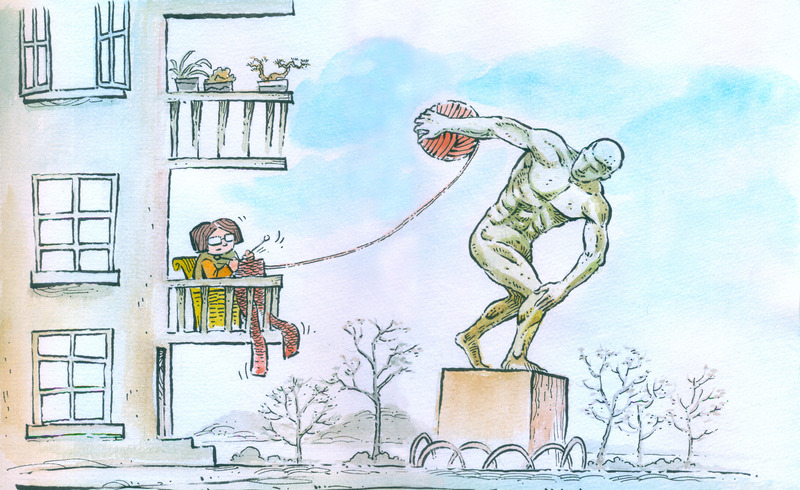Simple and powerful, his paintings are full of Chinese temperament, some say he is Impressionist
This year marks the 120th anniversary of the birth of Mr. Zhou Bichu, a famous Chinese oil painter and educator.
Not long ago, students and family members of Zhou Bichu, as well as renowned painters and critics in Shanghai, gathered at the Shanghai Oil Painting and Sculpture Institute where he had worked, and sat in front of his representative works to look back on his artistic career.
Zhou Bichu's paintings may seem plain and simple, but they contain touching power, which stems from his lifelong exploration of the integration of Western painting, traditional Chinese painting, and folk art.
Not a replica of Impressionism
In 1925, at the age of 22, Zhou Bichu graduated from Xiamen Art College and went to France to study. He was admitted to the National High School of Fine Arts in Paris and studied under the Impressionist painter Professor Ernest Laurent. The short 5-year study abroad period provided him with a spiritual foundation and a source of motivation for his long artistic career of over 60 years.

Luo Lang highly respects the long history of Eastern art. He once said to Zhou Bichu, "China has a very excellent painting tradition, which provides good learning conditions for painters. Chinese oil painting will have a bright future." He also used this analogy: "You are holding a golden rice bowl to beg for food." China's profound traditional culture is the "golden rice bowl" of Chinese painters.
After returning from studying abroad, Zhou Bichu has been exploring the integration of Western modernist art and traditional Chinese art. He often uses short strokes to draw, so some say he learned the painting techniques of Western dot painters Shura and Sinek.
Regarding this, Zhou Bichu said, "My teacher is not a punchlist, nor am I a punchlist at all. Drawing with small colored dots does not necessarily mean that I am a painter of this school. For example, animalist painters like Matisse often use colored dots to paint. Colored dots are just a technique of expression, like various texturing techniques in Chinese landscape painting. The so-called" one painting school "or" one ideology "not only refers to the brushstrokes on the painting, but mainly depends on the painter's creative ideas, material interests, and aesthetic views."
Zhou Bichu's "Ancient City and Water Town" 1961
There are indeed many color dots in Zhou Bichu's paintings, but upon closer inspection, one can see that these color dots are of varying thickness, length, and style, with overlapping strokes that are not mixed. Sometimes they resemble transparent watercolor painting techniques, while others show his exquisite reference to Chinese landscape techniques.

Art theorist Shao Luoyang understands Zhou Bichu in this way: he transformed the layers of ink and wash of Ming Dynasty Gong Xian into magical layers of colors, transformed the ink dots that symbolize bright and dense hemp into clusters of fresh dots, and his works after the age of 80 are closer to the ink and brush style of Shi Tao in the early Qing Dynasty. His paintings have the temperament of Chinese people and the charm of Chinese landscape painting.
As Zhou Bichu himself once said, "The Western Impressionism still draws inspiration from Eastern art, which is still a Western art school; the Eastern art draws inspiration from Impressionism, which cannot be a replica of them. It must be based on China and develop the Chinese art of the nation."
Zhou Bichu's "Indonesian Landscape" in 1958
Neither astonishing nor great
Years ago, after visiting Zhou Bichu's art exhibition, painter Wu Dayu excitedly said, "Zhou Bichu's paintings are poetry, poetry of music." These works combining poetry and painting may seem plain, neither astonishing nor great, some even imperfect, but as painter Wang Jieyin said, "I don't know why, there is a power in his paintings, an inner power that moves people very much."

This power comes from his profound traditional cultural heritage, as well as his unique pursuit of color. Art theorist and painter Qin Xuanfu once referred to Zhou Bichu as a "unique color painter.". Many of his works give people a feeling of slight dizziness in the sunlight, and the color used can be described as subtle and unique.
In the view of Li Shiwen, curator and artist at the Theoretical Research Office of Shanghai Oil Painting and Sculpture Institute, Zhou Bichu's colors do not entirely come from the Impressionist school of painting, but are more similar to the traditional Chinese art of random coloring. His paintings often change within the same type of color, with a bit of complementary color.
Zhou Bichu's "Spring Colors" in 1962
Painter Shao Longhai was once a student of Zhou Bichu and has restored many of his works. "Repairing Teacher Zhou's paintings is the most difficult part. His paintings are like simmering slowly, with constantly adjusting strokes. The use of the brush is so ingenious that it adds too many strokes and subtracts too few. Some people think his landscape paintings resemble Chinese paintings, while others think they resemble Impressionism. Regardless of the school, his paintings give people a feeling of beauty. This kind of beauty is not at all artificial, and this natural and naive makes his works very durable and often new to look at."
The painting "Spring Colors" depicts ordinary scenery in the suburbs of Shanghai, but it leaves a deep impression. That was painted by Zhou Bichu in the spring of the 1960s when he went to experience life in the Malu Commune. He rhythmically formed parallel color blocks of rose red peach blossoms, lemon yellow cauliflower, pink green wheat seedlings, and distant factories and residences, which looked like a rainbow from a distance.

"Beihai Park" is another representative work of Zhou Bichu, which is lyrical, rustic, elegant, and has a strong ethnic characteristic. These two paintings were both drawn with a scraper, using unique colors to fully unleash the brightness of the colors themselves, and they are bright but not flashy.
Zhou Bichu's "Beihai Park" in 1965
To draw a cloud
In the eyes of Chang Jiang Mei, the Shanghai Oil Painting and Sculpture Institute, Zhou Bichu's paintings have a simple power and a high-level sense of great music has the faintest notes. This simple and advanced style originated from Zhou Bichu's lifelong hard work in cultivation.
Zhou Bichu, who studied in Paris when he was young, often carried a painting box and stayed in a farmhouse. When he immigrated to Indonesia, he left his footprints from Jakarta to Bandung, from Mount Sarangan to Mount Mabi. In the late 1950s, Zhou Bichu returned to his long lost homeland. He traveled across the north and south of the country, using his paintbrushes to express the emotions of "the country's mountains and rivers are as brilliant as brocade.".

Even when he was an octogenarian, he climbed Mount Huangshan and Mount Wuyi, trekked the Lijiang River, the Taihu Lake Lake and the Yangtze River, and searched for all the wonderful mountains and landscapes. Although Impressionism, Expressionism, and other modernist arts did not dominate the art world for a long time, at the age of 76, Zhou Bichu astonishingly completed 24 works, entering another creative peak after immigrating to Indonesia.
Zhou Bichu sketched in Mount Huangshan
For painters, sketching from life is a common thing, but persisting in sketching from the scenery throughout one's life is not an easy task. Qiu Ruimin, a student of Zhou Bichu and a famous painter, remembers that Mr. Zhou usually doesn't talk much and likes to use "everything" to summarize what he wants to say. He often said, "The essence of sketching is to emphasize objectivity, observe carefully, and depict deeply, which is everything."
"I once had the privilege of accompanying my teacher to Jinggang Mountain and Yandang Mountain. We carried heavy luggage and painting tools through the mountains and crossed them, traveling heavy mountains during the day and staying at small inns at night. The rushing streams and undulating mountains were all visible. Although the teacher's works were not large in size, they had bright colors and vivid brushstrokes, which were the models we learned from. Many of his exquisite works originated from sketching." Qiu Ruimin recalled.
In the memories of his family, every time Zhou Bichu came back from sketching, his skin would always turn red from the sun. He would wait for one or two hours, sometimes even several days, in the wilderness to draw a cloud. He would first carefully ponder the picture when drawing still life, even the most familiar flowers or pen wash pots among painters. He would wait for several hours and think carefully before starting the painting. After completion, he would still carefully ponder, modify once, twice, or three times, and only sign his name after being satisfied.

In his later works, he integrated the traditional Chinese freehand brushwork spirit, folk painting techniques, and Western modeling techniques, emphasizing the capture and expression of instantaneous feelings in the process of sketching, thereby continuously expanding his new realm of oil painting art. For example, "The Little Three Gorges" created in 1984 and "The Former Residence of Lu You" created in 1987, both of which can only be felt in the scene of sketching, the vastness of heaven and earth, the vastness of the universe, and even the sense of air flow, were transformed into unique artistic images by Mr. Zhou Bichu. What is particularly commendable is that he used an oil painting knife, not an oil painting brush, to paint his works in a rather raw and spicy oil painting language. "The real feeling at a certain moment," said Fu Jun, Deputy Director of the Art Museum of Shanghai Oil Painting and Sculpture Academy, interpreting Zhou Bichu's works.
Zhou Bichu's "New Jubilee" in 1966
Encourage students to "make their own decisions"
Zhou Bichu is a simple person, a pure artist, and an educator who communicates with students.
In 1930, after completing his studies in France and returning to China, he successively taught at Xiamen Art College, National Hangzhou Art College, Shanghai Art College, and Shanghai Xinhua Art College. After returning from Indonesia in 1959, he taught at the Oil Painting Department of Shanghai Fine Arts College.

He always requires students to pay attention to reality, take nature as a teacher, give play to their creativity, and carry forward the essence of traditional art. When he sees a student copying a small picture, he will say, "Going outside to see the colors of nature will be more helpful to you." He guides students step by step to observe nature with the keen vision that an excellent painter must possess, but as for how to draw, he encourages everyone to "make their own decisions.". And he always discovers the strengths of each student and encourages them to pursue their own style.
Sculptor Wu Huiming said, "Zhou Bichu's landscape paintings may seem plain at first glance, without strong brushstrokes, but you can feel his broad mindedness, filled with mountains and rivers in his heart. His still life paintings give people a feeling of great care, and he pours all his love into his paintings. He always treats people around him sincerely in life. As his students, we have a deep feeling of his love."
Zhou Bichu's "Little Three Gorges" in 1984
Wei Jingshan, a student of Zhou Bichu and a famous painter, vividly remembers the scene of visiting Teacher Zhou's house: "He loves to plant flowers and plants. He enthusiastically introduced me to the experience of growing flowers, and when he saw that I really like flowers, he gave me some. Once, he found out that I like playing the violin, so he told me that he also played the violin in France when he was young, and he has always kept a very precious piano. When I asked to borrow this piano, he not only generously lent it to me, but also gave me many piano scores brought from France."
In 1995, student Ling Qining visited the critically ill Zhou Bichu at Ruijin Hospital and said, "When I get better, I still want to draw."

This time, it is the final farewell between the master and disciple.




